#chemiosmosis
Text
“to test how your blood oxidizes, let’s say i place a bag over [my name]’s head.” —my bio teacher first period, zoning me back into class
5 notes
·
View notes
Text
I feel like a finally have a decent handle on the steps and processes of aerobic cellular respiration! This is vindication for my 16 year old self, who was sooo confused by "the Kreb's Cycle" and "some other really complicated process but how are they related?" (which was probably the election transport chain. chemiosmosis and the proton gradient seemed completely new to me, so I don't know if I never learned about them or just totally lost them from memory. or they weren't known back when I was in high school? They're kind of the whole point of it all so it seems odd to gloss over them.)
Also, I actually feel like I have a better grasp on oxidation and reduction after trying to understand cellular respiration. Which surprised me for some reason, although in retrospect it shouldn't have. So yay!
#I understood it well enough to do well on tests and the AP exam#I should have finished with this section on FRIDAY but alas my executive function has been rebelling all weekend and now it's 11pm Sunday#hw lb#gillianthecat goes back to school#biology#biochemistry#cellular respiration#my life with adhd#🧠=🦐
4 notes
·
View notes
Text
Respiration notes [My A-level Notes]
Definition:
-Respiration is the metabolic reaction by which chemical potential energy released via the breakdown of organic molecules is used in ATP synthesis. Respiration is of two types: aerobic and anaerobic
The structure of ATP:
- Adenosine triphosphate
- ATP is a phosphorylated nucleotide
- It is made up of an organic base [adenine], a ribose sugar and 3 phosphate groups [negatively charged]
- Adenine + ribose —-> Adenosine
- Adenosine + organic phosphate —-> Adenosine monophosphate [AMP]
- AMP + organic phosphate —-> Adenosine diphosphate [ADP]
- ADP + organic phosphate —-> Adenosine triphosphate [ATP]
- ATP is the body’s way of temporarily storing chemical potential energy in small transportable packages which can then be moved to energy-deficient sites where they release their energy
- The release of energy from ATP involves the hydrolysis of the molecule. The enzyme ATPase is involved in this reaction
- ATP —-> ADP + organic phosphate [30.5 kJ/mol]
- ADP —-> AMP + organic phosphate [30.5 kJ/mol]
- AMP —-> Adenosine + organic phosphate [14.8 kJ/mol]
- Therefore a single mole of ATP releases an average of 75.8 kJ of energy when completely broken down
What makes ATP a ‘universal energy currency’?
1. It’s a small molecule
2. Soluble
3. Hydrolysis of ATP is relatively quick
4. No energy wastage (energy is only released in specific amounts that are sufficient to sustain bodily functions)
5. Recyclable
6. Can be transported easily within cell
Examples of energy-requiring processes/mechanisms:
1. Sodium-potassium pump: 3 sodium ions are pumped out and 2 potassium ions are pumped into the cell against their respective concentration gradients [active transport and therefore requires energy]
2. Anabolic reactions [synthesis of complex molecules from simpler ones]: DNA replication, protein synthesis, phosphorylation
3. Movement: mechanical movement [muscle contraction] and movement of chromosomes due to action of spindle fibers
4. Transmission of nerves impulses
Aerobic respiration:
- Involves four stages: Glycolysis, Link reaction, Krebs cycle and Electron Transport Chain [ETC]
- Requires oxygen
- Involves the complete breakdown of glucose
- Occurs in the mitochondria (except glycolysis)
The structure of the mitochondria:
- Site of aerobic respiration
- Has double membranes
- The outer membrane is smooth are more permeable to substances
- The inner membrane is less permeable are has infoldings known as cristae.
- Cristae are responsible for increasing the surface area of the inner mitochondrial membrane, facilitating the presence of a larger number of ATP synthases and electron carrier proteins.
- This results in a higher rate of ATP synthesis.
- The intermembrane space is the space between the inner and outer membranes.
- Within the inner membrane is an aqueous solution known as the matrix. It contains enzymes, 70S ribosomes and circular DNA
Phosphorylation:
- Phosphorylation is of two types : Substrate-linked and chemiosmosis/oxidative phosphorylation
- Substrate-linked phosphorylation involves the direct transfer of an organic phosphate from a substrate to an ADP molecule using energy directly provided by another chemical reaction. It’s the type of phosphorylation that occurs in both glycolysis and the Krebs cycle
- Chemiosmosis, on the other hand, involves the presence of a proton gradient produced by the pumping of protons from the mitochondrial matrix to the intermembrane space using the energy released as a direct result of the movement of electrons from a high to low energy across the electron transport chain [involves carrier protons]. The protons then move back into the matrix using facilitated diffusion through ATP synthase [ present in inner membrane of mitochondria] . This in turn releases energy which is used to synthesize ATP. 3 protons passing through ATP synthase results in the production of one ATP molecule. Chemiosmosis occurs across MEMBRANES [ inner mitochondrial membrane for respiration, thylakoid membrane for photosynthesis]
Glycolysis:
- A glucose molecule is phosphorylated via substrate-linked phosphorylation. This step requires 2 ATP molecules
- This results in the production of a fructose-1,6-biphosphate molecule [6C]
- Fructose biphosphate is then broken down into two triose phosphate molecules [3C]
- Next, each triose phosphate molecule undergoes both oxidation and the removal of its phosphate group and is therefore converted into a pyruvate molecule
- The removed phosphates combine with ADP to form 4 ATP molecules. A net of 2 ATP molecules is produced during glycolysis [as 2 are initially used in the phosphorylation of glucose]
- The oxidation of triose phosphate also results in the reduction of a coenzyme called NAD. Two NADH [reduced NAD] molecules are produced
- Glycolysis occurs in the cytoplasm
Link reaction:
- Pyruvate [the end product of glycolysis] is then transported to the mitochondrial matrix
- Pyruvate undergoes two important reactions here: decarboxylation and dehydrogenation
- Decarboxylation involves the removal of carbon dioxide (1C) from pyruvate (3C) to produce a two-carbon compound (2C)
- Dehydrogenation involves the removal of hydrogen from pyruvate. This hydrogen is then picked up by the coenzyme NAD, resulting in the production of NADH
- The 2C compound then undergoes a reaction with coenzyme A [CoA] which produces acetyl coenzyme [ ACoA]
- Overall reaction: pyruvate + NAD + CoA —-> ACoA + NADH + CO2
Krebs cycle:
- Each original glucose molecule undergoes two turns of the cycle.
- The Krebs cycle involves two vital molecules: oxaloacetate (4C) and ACoA (2C).
- Oxaloacetate accepts the 2C fragment from acetyl coenzyme, resulting in the production of citrate (6C)
- Like pyruvate, citrate undergoes both decarboxylation and dehydrogenation.
- The purpose of this step is to produce hydrogens which can then be picked up by the coenzymes NAD and FAD
- It produces CO2, which is a waste gas
- Oxaloacetate is reformed and can recombine with ACoA
- During each turn of the cycle, 3 NADH, 1 FADH2, 2 CO2 and 1 ATP molecules are produced
- In other words, the Krebs cycle produces 6 molecules of reduced NADH, 2 molecules of reduced FAD, 2 molecules of carbon dioxide and 2 molecules of ATP for every molecule of glucose
Electron Transport Chain:
- Part of the inner mitochondrial membrane
- NADH and FADH2 release their hydrogens
- Each hydrogen is then broken down into a proton and an electron
- The protons accumulate in the matrix while the electrons move through the electron transport chain. This movement involves jumping across several electron carrier proteins, which effectively releases energy
- This energy is then used to pump protons into the intermembrane space
- This movement generates a proton/chemiosmotic gradient
- Protons flow back into the matrix via facilitated diffusion and through ATP synthase
- The movement of protons through ATP synthase results in the synthesis of ATP
- An ATP molecule is produced for every 3 protons that flow into ATP synthase
- Oxygen acts as the final acceptor of both electrons and protons in this case, where it combines with both of them to produce water
- Therefore, this type of phosphorylation is called oxidative phosphorylation [ chemiosmosis]
- 32 ATP molecules are produced during this process, making it the major contributor to the energy released during aerobic respiration
Why do fats have a higher energy density than carbohydrates?
- Energy density is determined by the number of hydrogen atoms within a molecule
- This is because the release of hydrogen atoms by NADH and FADH2 directly results in the production of protons
- These protons are then pumped out into the intermembrane space
- The more protons in the intermembrane space, the steeper the proton electrochemical gradient
- A steep electrochemical gradient results in more protons flowing back in through ATP synthase, and thus more ATP synthesis.
- Fats have more hydrogen atoms per molecule than carbohydrates, which is the cause behind their high energy density
Anaerobic respiration in yeast/ plants:
- Anaerobic respiration occurs in the absence of oxygen
- It produces less energy than its aerobic counterpart, due to the incomplete breakdown of glucose
- In yeast the overall reaction is : glucose —-> ethanol + carbon dioxide
- It involves two steps: glycolysis and fermentation
- Anaerobic respiration is characterized by the absence of the link reaction, Krebs cycle and electron transport chain
- This is because of the inability to reform NAD in these processes in the absence of oxygen
- However, glycolysis still occurs as NAD is regenerated
- Glycolysis results in the formation of both pyruvate and reduced NAD
- During the fermentation step, pyruvate (3C) undergoes decarboxylation using the enzyme pyruvate decarboxylase, resulting in the production of ethanal (2C)
- Ethanal then combines with reduced NAD to produce ethanol using the enzyme alcohol dehydrogenase
- The overall reaction is : pyruvate + NADH —-> ethanol + CO2 + NAD
- Thus, NAD is reformed and the reaction continues to take place
- 2 ATP molecules are produced
- This reaction is irreversible and leads to energy wastage
- Anaerobic respiration is useful in plants as it allows them to adapt to the continuous lack of oxygen in their environment
Anaerobic respiration in mammals:
- Also involves glycolysis and fermentation
- The difference, however, is that pyruvate directly combines with reduced NAD to produce lactate [lactic acid] using the enzyme lactate dehydrogenase
- The overall reaction is: pyruvate —-> lactate
- 2 ATP molecules are produced
- This reaction is reversible
- In fact the reverse process occurs in the liver, where lactate is converted to pyruvate to due to lactate’s toxic nature
Adaptations of rice for wet environments:
1. Cells are tolerant to high ethanol concentrations: The low oxygen concentrations present in wet environments compared to that found in the air spaces in soil means that anaerobic respiration frequently takes place, producing large volumes of ethanol
2. Stems have air spaces known as aerenchyma which facilitate the diffusion of oxygen down to the plant’s roots
3. Some plants have the capacity for elongated stem growth, exposing the leaves to oxygen on the surface
I’ll come back to try and make this presentable when I’m less sleep desprived lol. Corrections and constructive criticism are welcome as always!
0 notes
Text
Progress Report: Mission Log 21?
How does one justify our modicum of ethics and morality, thoroughly addressing the physical hierarchy within which we are entrenched?
As much as I found it appealing and convenient to adopt the humanistic and democratic ethics of my time, it wasn't all too certain with its origins nor its foundations - I found it troublesome, almost in a similar fashion to Socrates of all people that, when consulting any number or variations of my community, I was met with the same vulgar (in the older sense of the term) answer: not one of them understood the metaphysical or ontological foundations of even their moral or ethical systems within which they found themselves or, even worse, the double potential of the American hodgepodgery that Nietzsche, Mencken, and other authors have made me privy to, in certus - specifically, this "melting pot" potential to become this anonymous grey mass of values. Perhaps this is why, with alluding to Nietzsche's use for having many masks, and even, perhaps, in his mentions of the "roguish vice, politeness", has the chameleon-like ability to become whatever the use occasions, in the worse combinations of a servile-yet-Machiavellian addling of the individual as person... to the "individuum"; to the anonymous "human being"...
But this probably is all too much at the start of a rather simply logging of my progress towards my ambitions... Indeed, Levinas, amidst other forays, or mere ventures into the unknown; what has been unknown to a great many people for a long time, has simply amounted to this for me: to log all these kinds of systems, as to ascertain the true lineage of humanity-as-such; the "human-all-too-human" decline of our nature as "homo" "sapiens"... I have Nietzsche and Evola to thank for the curtailing of my long, tiresome detour in the morasses of more-and-more asses that have plagued the human intellect. Whether it be the "intelligent stupidity" that Evola speaks to, which I had already discerned as being a plague on humanity vis-à-vis the intelligentsia and bourgeoisie of the last several centuries, or if it has been the teaching of lower beings (myself included) of the lack of dignity in their lowly position, when it comes to their respective strata of society for, with regard to the stability of society and State, in the higher senses of those terms, the lower strata (the merchants and the sudras of the world) has arrogated too much to themselves, where it isn't deserved; where, funnily, arrogance, in the modern sense of the term, is the only thing that rightly should be deemed of them, in this motley assumption that the Immortal Principles of the French Revolution give any credence to their anarchical disobedience; their deciding to "throw away their chains", as Nietzsche calls it. No wonder that Existentialism and Absurdism took off as philosophical movements, like they did in France (not to mention the feminism of De Beauvoir, or the artistico-political movement of Negritude). Understanding the political movements of Sovietism and Marxism make it easy enough to understand these detours, to which led me to that interest in the philosophical underpinnings of these systems - the confusion of things like Being and Becoming; the phenomenon and "noumenon", "otherness", and other such terms demarcate the exacting schisms that make for the democratic "triumph" that Nietzsche expresses.
Making it a leisure to explore these topics are indeed my "untimely meditations". Once I've finished this philosophical detour, and perhaps also writing on such a venture, I'd like to return to my interest in these "first principles of physiology" that I find aren't entirely unpalpable, specifically with John Torday in mind (namely, his theory considering 'homeostasis, chemiosmosis, and negentropy' to be these first principles). This was, above all, my serious concern, with regard the above mentioned physical hierarchy (e.g. Torday's mention of lung development via alveoli, and his use of Tiktaalik -) What could derived from understanding evo-devo (evolutionary developmental biology) in this manner? Something I had previously ventured into, with this idea of physical hierarchy in mind, also was this attempt to develop interpersonal neurobiology (IPNB)...
This will only start to become navel gazing, as I'd just be speculating on future turning points for my research; it'd even be ironically mercurial...
For now, I shall wrap up these current endeavors, alongside with making sure I document these experiences in my physical journal; it will also be noted that I've started a Goodreads profile as a preamble to my much anticipated (I'm shaking in my shoes, just thinking about it) "bibliography" that I've alluded to in months/years past.
Adieu
0 notes
Photo
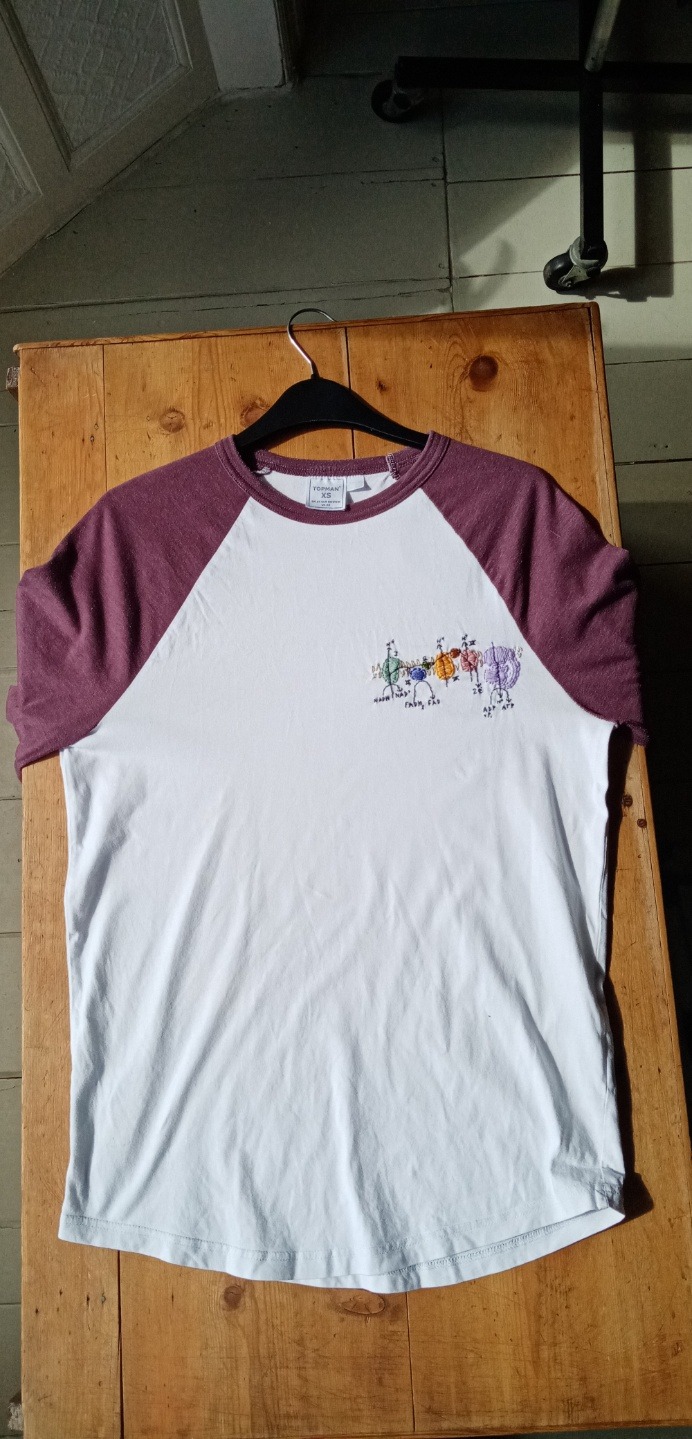
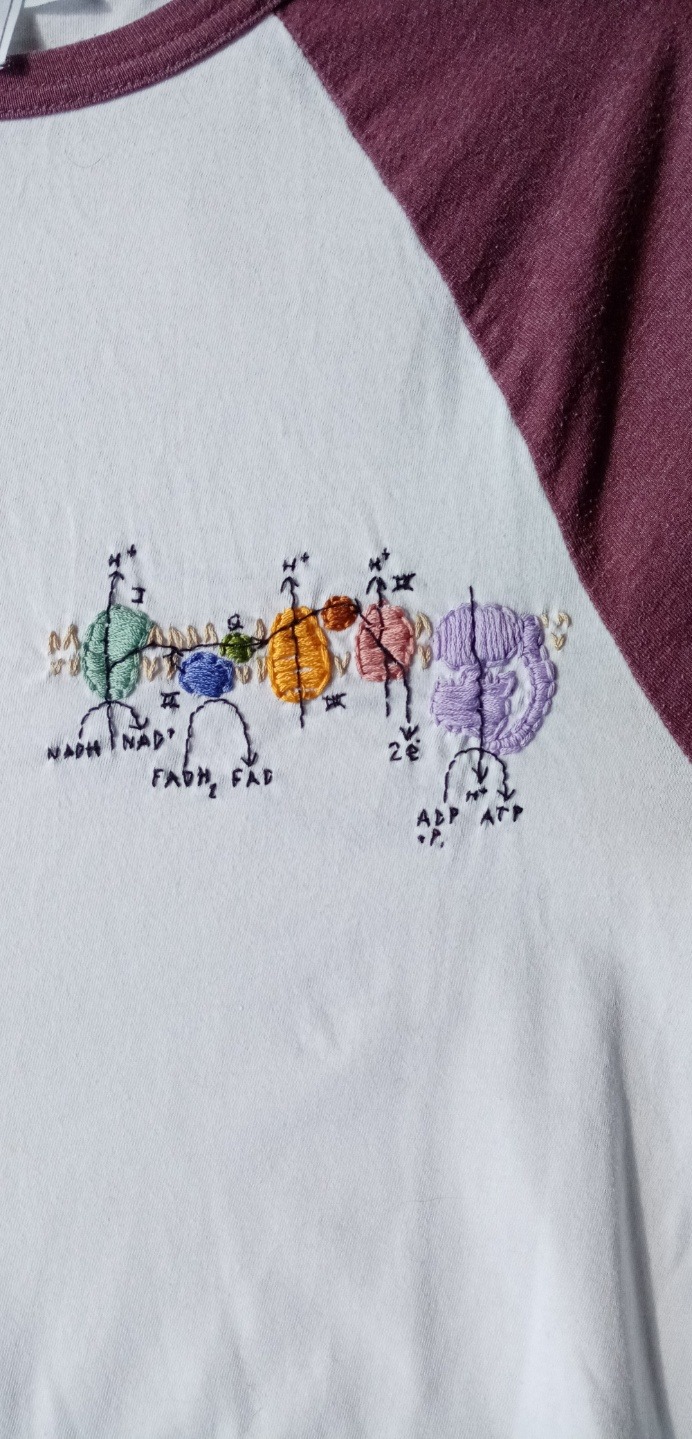
Molecular embroidery!
The oxidative phosphorylation pathway and chemiosmosis (on a shirt!)
#biology#biochemistry#molecular biology#microbiology#chemistry#organic chemistry#inorganic chemistry#microscope#Microscopy#microorganisms#embroidery#molecule#molecules#oxidative phosphorylation#chemiosmosis#respiration#NADH#FADH2#ATP
383 notes
·
View notes
Text
Cell Respiration
Cell respiration is a series of oxidative reactions, where cells release energy from glucose and transfer it into adenine triphosphate (ATP). The energy stored in ATP is used in most essential functions. The byproducts of cell respiration are wafter and CO2, which are the reactants in photosynthesis.

When one phosphate group is removed from ATP, it becomes the more stable and lower energy molecule, ADP. Energy is required to make ADP into ATP, and a byproduct when ATP becomes ADP.

Structure of the Mitochondrion
The mitochondrion is enclosed by two membranes, the outer membrane, and the inner folded cristae membrane/ This inner membrane divides the mitochondria into the outer compartment, and the matrix. The Krebs cycle takes place in the matrix, and the electron transport chain takes place in the cristae membrane.

There are two kinds of respiration: aerobic and anaerobic, depending on if oxygen is present. When oxygen is not present (anaerobic), glycolysis is followed by alcohol fermentation or lactic acid fermentation. If oxygen is present, glycolysis is followed by the Krebs cycle, the electron transport chain, and chemosmosis.
Anaerobic respiration originated billions of years ago when oxygen was not as free as it is today. It is what makes our muscles ache when we exercise, and also how alcohol is made.
Glycolysis
Glycolysis is the anaerobic phase of aerobic respiration. One molecule of glucose breaks into two molecules of pyruvate or pyruvic acid. It occurs in the cytoplasm and is controlled by different enzymes. 2 ATP is needed to start the reaction, and it produces 2 Pyruvates, 4 ATP (net gain 2 ATP), and 2 NADH.
In anaerobic respiration, after glycolysis is either:
Alcohol fermentation: where certain cells turn pyruvic acid into ethyl alcohol and CO2
or lactic Acid fermentation, which occurs in our bodies when they cannot keep up with the demand for oxygen when we exercise. Pyruvic acid is converted into lactic acid which builds up and causes pain. The liver converts lactic acid back into pyruvic acid.
Aerobic Respiration
After glycolysis, if oxygen is present comes the Krebs cycle.
The Krebs Cycle/Citric Acid Cycle
Pyruvic acid combines with coenzyme A (vitamin A derivative) to create Acetyl-CoA which is used during the Krebs cycle. It occurs in the matrix of the mitochondria. Each turn of the Krebs cycle produces 1 molecule of ATP and FADH2 and 3 molecules of NADH.
NADH and FADH2
Along with ATP, NADH and FADH2 are important parts of cell respiration. They are coenzymes that shuttle protons and electrons from glycolysis and the Krebs cycle to the electron transport chain.
NAD+ is the oxidized form, NADH is the reduced form. FAD+ is the oxidized form, FADH2 is the reduced form.
The Electron Transport Chain and Chemiosmosis
The electron transport chain (ETC) takes place within the cristae membrane. Each ETC consists of a series of carrier molecules that move high energy electrons from the Krebs cycle. The energy from these electrons powers the pumping of protons across the cristae membrane to the outer compartment, forming a proton gradient. The potential energy from this proton gradient is used to make ATP via chemiosmosis or oxidative phosphorylation. Most ATP comes from chemiosmosis
NADH and FADH2 carry high energy electrons from the Krebs cycle and glycolysis to the ETC. As the electrons are pulled along the ETC, they release energy used to push protons (H+) across the cristae membrane which creates the proton gradient. This represents potential energy.
Chemiosmosis uses this energy to turn ADP into ATP. Chemiosmosis relies on ATP synthetase to function. This molecule is a proton channel structure that spins. As protons move through the ATP synthetase channel, a part of the molecule turns and attaches phosphates to the ADP molecules.
Oxygen is attracted to electrons and protons. It pulls the electrons through the ETC and is the final electron and proton acceptor in the ETC. When O2 combines with protons and electrons at the end of the ETC, water is formed which is exhaled
The ETC is a collection of carrier molecules (including cytochromes) embedded in the cristae membrane of mitochondria
Each mitochondrion contains thousands of ETCs
The ETC carries electrons through a series of redox reactions, as special molecules bind to and let go of electrons.
Protons cannot diffuse across the cristae membrane, and so are aided by ATP synthetase channels
In theory, each proton carried by a NAD molecule produces 3 ATP, while each proton carried by a FAD molecule produces 2 ATP molecules.
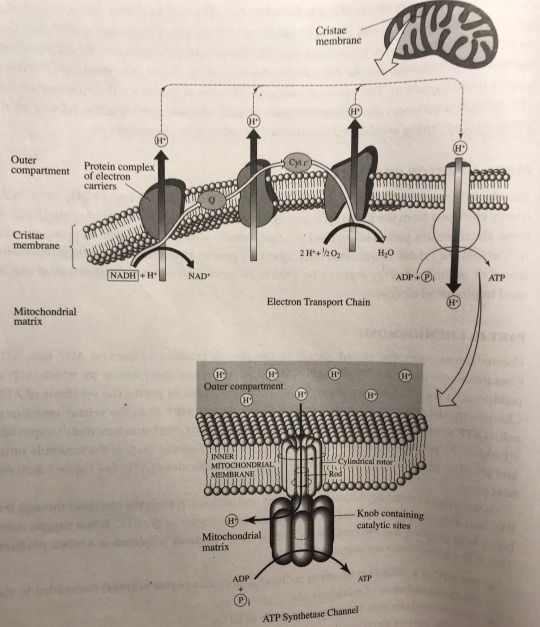

#cell respiration#glycolysis#aerobic respiration#anaerobic respiration#electron transport chain#krebs cycle#chemiosmosis#biology#biology studyblr#animal biology#plant biology#studyblr#sat subject test#sat biology
70 notes
·
View notes
Text

Patreon | Ko-fi
#studyblr#notes#biology#chemistry#biochemistry#bio#chem#biochem#electrons#atp#chemiosmosis#h2o#nadph#o2#photolysis#h+
1 note
·
View note
Note
To the anon looking for fics in which exo are soldiers. I guess I can recommend two fics that may interest you: 1. Bluebirds in The Moonlight by rainsblankpage (it's a chanbaek though and technically only Chanyeol goes to war but it's super-good) 2. Galatea by chemiosmosis (it's sekai and though they are not soldiers themselves the story is set in the middle of ww2 and it's really interesting!+careful! it's still unfinished tho the author updates regulary) Hope my suggestions will come useful
190829
thank you, the post has been updated!
-jen
4 notes
·
View notes
Text
The only thing getting me through my studying for finals right now is thinking what would Ronan Lynch do and then angrily in all caps and bold writing a list of all the shit I’m bad at to study. Observe:
SHIT I DON'T NOR HAVE I EVER UNDERSTOOD:
-DNA REPLICATION: THAT SHIT'S CONFUSING. FIGURE IT OUT
-AEROBIC RESPIRATION, CHEMIOSMOSIS, KREBS CYCLE AND ALL THAT BULLSHIT: MISSED A CLASS. MARIAH IS A GOOD FRIENDS BUT NOT SUCH A GREAT TEACHER AND THAT SHIT IS CONFUSING AS FUCK.
-THAT KINGDOM PHYLUM BULLSHIT. IT'S TOO LONG AND YOU NEVER BOTHERED TO LEARN IT BUT IT ALWAYS BITES YOU IN THE ASS
-THAT WATER SHIT IT’S ALWAYS ON THOSE DAMN PAPERS
-CLIMATE CHANGE SHIT: IT’S RELEVANT TO SOCIETY SHIT SO I THINK IT'LL BE ON THERE JUST SO THEY CAN TRAUMATISE US MORE
#ronan lynch#the raven cycle#trc#studying#school#exams#finals#guys imma fail my bio one#bllb#dt#tdt#trk#trb
13 notes
·
View notes
Text
The citric acid cycle can produce
The citric acid cycle can produce
25. Which of the following process takes place only in the stroma of chloroplast? (a) Calvin cycle (c) Glycolysis (b) Krebs cycle (d) chemiosmosis 26. The citric acid cycle can produce (a) NADH (c) FAD (b) FADH; (d) both a and b 27. The alcohol fermentation produces (a) ethanol only (c) ethanol and CO2 (b) lactate only (d) lactate and CO2 28. Which of the following polymers of glucose is! used as…

View On WordPress
0 notes
Text
The Electron Transport Chain
This chain is a series of electron carriers in the membrane of the mitochondria. Through a series of reactions, “high energy” electrons are passed to oxygen. Then a gradient is formed, and ATP is produced.
Therefore, the electron transport chain creates a gradient through which ATP can be made known as chemiosmosis.
The electron transport chain produces 32 ATP.
Electron transport requires oxygen directly( aerobic respiration).
0 notes
Text
Photosynthesis
While cell respiration produces CO2 and water as byproducts, photosynthesis uses CO2 and water. It produces sugar and oxygen as byproducts (along with water) which is necessary for cell respiration.
The Chloroplast
Photosynthesis occurs within the chloroplast. The chloroplast is an organelle enclosed by a double membrane. It contains grana (containing layers of membranes called thylakoids). This is where the light-dependent reactions occur, and the stroma, where the Calvin Cycle (light-independent reactions) occur.
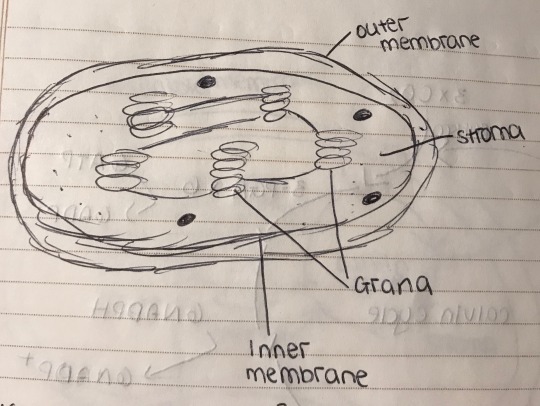
Light and Photosynthetic Pigments
When light hits an object, it is either reflected, transmitted, or absorbs. If you look at a yellow lemon, that yellow lemon absorbs all other colours, other than yellow, which it reflects, causing you to perceive it as yellow. If you shine green light on a green plant, all the light would be reflected, and the plant would die.
Photosynthetic pigments absorb light energy and use it for photosynthesis. Substances that absorb light in the visible spectrum are pigments.
Chlorophyll a, the green photosynthetic pigment participates directly in light-dependent reactions. Other pigments, also called antennae, or accessory pigments assist in photosynthesis by capturing and passing photons of light to chlorophyll a, expanding the range of light that can be absorbed.
Chlorophyll b, carotenoids, and phycobilins are all examples of accessory pigments. Chlorophyll b is green, carotenoids are yellow, orange and red, and phycobilins are red. (Red algae in the deep ocean have these pigments

Light-Dependent and Light-Independent Reactions
Light-Independent reactions used to be called dark reactions, however, we now know that both reactions only can occur in the light.
Light-Dependent Reactions
Light-dependent reactions occur in the grana, within the thylakoid membranes. Thylakoid membranes are filled with light-absorbing complexes called photosystems. They contain chlorophyll a, chlorophyll b, and carotenoids. It is during this stage of photosynthesis that huge amounts of ATP are produced.
ATP is produced in chloroplasts the same way as in mitochondria, through ETC’s and chemiosmosis. When chlorophyll absorbs light, the electrons become energized, escape from the chlorophyll and enter the ETC. The energy from these electrons pumps protons across the thylakoid membrane, creating the protein gradient. The potential energy created by this is used to make ATP as protons flow through ATP synthetase channels.
Water is necessary to replace the lost electrons. Water breaks down via photolysis into its components: electrons, protons, and oxygen atoms.
The electrons replace what the chlorophyll lost. The protons pass through ATP synthetase channels and are carried by NADP to the stroma to participate in light-independent reactions. Oxygen is released as a waste product.
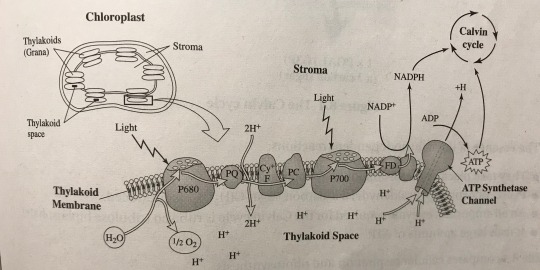
Light-Independent Reactions
While light-dependent reactions make energy, light-independent reactions make the sugar PGAL. It occurs in the stroma. CO2 combines with protons and electrons from the light-dependent reactions, carried by NADP to make PGAL.
When CO2 is incorporated into a sugar molecule, it is called carbon fixation. This takes place during the Calvin cycle, which requires a lot of ATP. It also requires the enzyme rubisco in order to take place.
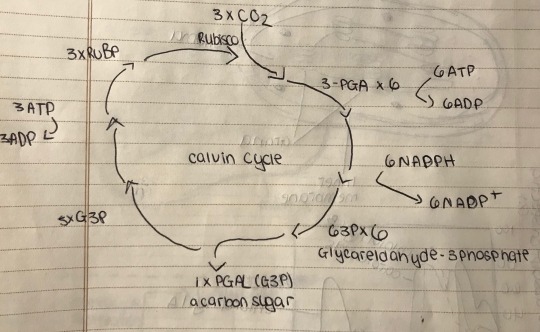


Structure of the Leaf
The palisade layer consists of tightly packed cells containing chloroplasts. This is where the majority of photosynthesis occurs. The spongy mesophyll also contains chloroplasts, however, they are less tightly packed, as they are surrounded by air spaces which allow the exchange of oxygen, carbon dioxide, and water vapour. The epidermis does not carry out photosynthesis. Above the epidermis is the waxy cutin called cutin, minimizing water loss. Guard cells open and close stomates which are necessary for gas exchange. Guard cells can photosynthesise.

#photosynthesis#plant biology#light-dependent reactions#light-independent reactions#calvin cycle#biology#biology studyblr#studyblr#sat subject test#sat biology
24 notes
·
View notes
